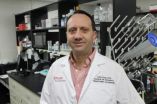(Press-News.org) TORONTO, ON, February 24, 2014 —Women who carry a BRCA gene mutation and opt for a preventive oophorectomy, or ovary removal surgery, have a 77 per cent lower risk of death than those who do not, according to a new study led by Women's College Hospital's Amy Finch and Dr. Steven Narod.
Research has long shown that preventive oophorectomy reduces the risks of ovarian and breast cancers in women with a BRCA gene mutation, but the best age for women to have the surgery and its impact on mortality has not been well studied. The findings by Finch and colleagues, published today in the Journal of Clinical Oncology, are the first to look at these effects among a large cohort of women over a nearly six-year followup period.
"Scientific evidence clearly shows removal of a woman's ovaries and fallopian tubes is very effective in preventing both breast and ovarian cancer in women with a BRCA mutation," said Finch, a researcher at Women's College Research Institute and the study's lead author. "But the real question has been at what age these women should have the surgery to best diminish their chance of developing cancer."
In the study, researchers evaluated the effect of a preventive oophorectomy in reducing death and the risk of ovarian, fallopian tube or peritoneal cancer in 5, 783 women with a BRCA gene mutation. They found the surgery was associated with:
An 80 per cent reduction in the risk of ovarian, fallopian and peritoneal cancer
A 77 per cent lower risk of death from all causes and
A 68 per cent lower risk of death from all causes in women who previously had breast cancer
"Our study supports the notion that women who carry a BRCA gene mutation will have a much lower risk of developing or dying from cancer if they have an oophorectomy at age 35," said Dr. Steven Narod, a co-author of the study and senior scientist at Women's College Research Institute. "If a woman with a BRCA1 mutation opts to delay the surgery until age 40 or 50, her chance of developing ovarian, fallopian tube or peritoneal cancers jumps to 4 and 14.2 per cent, respectively."
While oophorectomy is a safe procedure, it can carry some complications, including premature menopause.
"After an oophorectomy, the long-term effects on a woman's cardiovascular health and her bone health are less well known, and further research is needed," Finch added.
Finch and Dr. Narod, along and colleagues from Women's College Hospital and the University Health Network, are now examining these potential impacts in a new study to gain a better understanding of the risks of a preventive oophorectomy for women with a BRCA mutation.
While the decision to undergo oophorectomy is life altering, particularly for young women, these findings showing the clear benefit of this surgery on cancer risk and mortality and will strengthen the recommendation for this surgery, the researchers said.
INFORMATION:
Preventive oophorectomy reduces risk of death by 77 percent for women with BRCA mutation
2014-02-24
ELSE PRESS RELEASES FROM THIS DATE:
Study shows preventive ovarian surgery in BRCA1 mutation carriers should be performed early
2014-02-24
The findings of a large international prospective study published in the Journal of Clinical Oncology suggest for the first time that women with BRCA1 mutations should have preventive ovarian surgery (prophylactic oophorectomy) by age 35, as waiting until a later age appears to increase the risk of ovarian cancer before or at the time of the preventive surgery. Women with a BRCA2 mutation, however, do not appear to be at an increased risk by age 35, suggesting they may delay this procedure until later. Moreover, women with BRCA1 and BRCA2 mutations who had this surgery ...
JCI online ahead of print table of contents for Feb. 24, 2014
2014-02-24
Clinical trial assesses anti-FGF23 for treating X-linked hypophosphatemia
X-linked hypophosphatemia (XLH) is a heritable form of rickets that results from mutations in the gene encoding the phosphate regulating endopeptidase (PHEX). Unlike diet-associated forms of rickets, XLH cannot be ameliorated by vitamin D ingestion. XLH patients have increased serum levels of FGF23, which decreases both inorganic phosphate (Pi) and the activated form of vitamin D. In this issue of the Journal of Clinical Investigation, Thomas Carpenter and colleagues at Yale University evaluated ...
Seed dispersal gets a test in carved-out 'habitat corridors'
2014-02-24
MADISON, Wis. — Field ecologists go to great lengths to get data: radio collars and automatic video cameras are only two of their creative techniques for documenting the natural world. So when a group of ecologists set out to see how wind moves seeds through isolated patches of habitat carved into a longleaf pine plantation in South Carolina, they twisted colored yarn to create mock seeds that would drift with the wind much like native seeds.
The "seeds" were dusted with fluorescent powder and inserted into custom-made boxes mounted on poles, then released as the scientists ...
Better livestock diets to combat climate change and improve food security
2014-02-24
Livestock production is responsible for 12% of human-related greenhouse gas emissions, primarily coming from land use change and deforestation caused by expansion of agriculture, as well as methane released by the animals themselves, with a lesser amount coming from manure management and feed production.
“There is a lot of discussion about reduction of meat in the diets as a way to reduce emissions,” says IIASA researcher Petr Havlík, who led the study “But our results show that targeting the production side of agriculture is a much more efficient way to reduce greenhouse ...
Marine algae can sense the rainbow
2014-02-24
A new study published in Proceedings of the National Academy of Sciences has shown for the first time that several types of aquatic algae can detect orange, green and blue light.
Land plants have receptors to detect light on the red and far red of the spectrum, which are the common wavelengths in the air. These plants sense the light to move and grow as their environment changes, for example when another plant shades them from the sun. But in the ocean, the water absorbs red wavelengths, instead reflecting colours such as blue and green. As part of the study, a team of ...
A paper diagnostic for cancer
2014-02-24
CAMBRIDGE, MA -- Cancer rates in developing nations have climbed sharply in recent years, and now account for 70 percent of cancer mortality worldwide. Early detection has been proven to improve outcomes, but screening approaches such as mammograms and colonoscopy, used in the developed world, are too costly to be implemented in settings with little medical infrastructure.
To address this gap, MIT engineers have developed a simple, cheap, paper test that could improve diagnosis rates and help people get treated earlier. The diagnostic, which works much like a pregnancy ...
Species conservation poised to benefit from DNA advances
2014-02-24
A biologist at the University of York is part of an international team which has shown that advanced DNA sequencing technologies can be used to accurately measure the levels of inbreeding in wild animal populations.
The research by senior author Dr Kanchon Dasmahapatra, of the Department of Biology at York, and led by Dr Joseph Hoffman, of the Department of Animal Behaviour, Bielefeld University, Germany, may help efforts to conserve rare species.
Laboratory studies show that inbreeding reduces fitness. However, studying the impact of inbreeding in wild populations has ...
Acupuncture holds promise for treating inflammatory disease
2014-02-24
When acupuncture first became popular in the western hemisphere it had its doubters. It still does. But over time, through detailed observation, scientists have produced real evidence that ancient Chinese practitioners of the medical arts were onto something.
Now new research documents a direct connection between the use of acupuncture and physical processes that could alleviate sepsis, a condition that often develops in hospital intensive care units, springs from infection and inflammation, and takes an estimated 250,000 lives in the United States every year.
"Sepsis ...
New study shows a genetic link between feeding behavior and animal dispersal
2014-02-24
New research from the University of Toronto Scarborough shows that animal dispersal is influenced by a gene associated with feeding and food search behaviours.
The study, which was carried out by UTSC Professor Mark Fitzpatrick and PhD student Allan Edelsparre, provides one of the first aimed at gaining a functional understanding of how genes can influence dispersal tendencies in nature.
Using common fruit flies (Drosophila melanogaster), the researchers observed how two different foraging types – known as sitter flies and rover flies – moved over large distances ...
Ecotourism reduces poverty near protected parks, Georgia State University research shows
2014-02-24
ATLANTA--Protected natural areas in Costa Rica reduced poverty by 16 percent in neighboring communities, mainly by encouraging ecotourism, according to new research published today in the Proceedings of the National Academy of Sciences.
Although earlier studies indicated that establishing protected areas in poor regions can lead to reductions in poverty, there was no clear understanding why or how it happens.
"Our goal was to show exactly how environmental protection can reduce poverty in poorer nations rather than exacerbate it, as many people fear," says co-author ...


